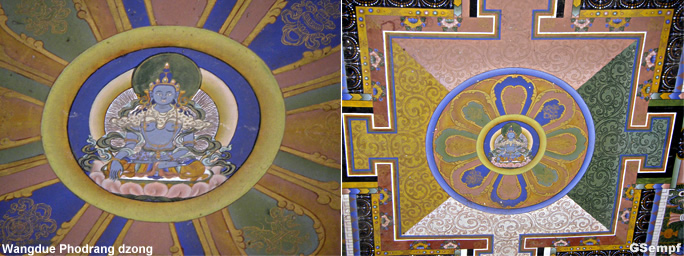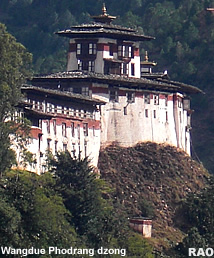| You are here: | Home > Bhutan > Overview > Culture > Religion > Dzongs > Wangduephodrang Dzong > Fire 2012 > Reconstruction | Search |
 |
| Bhutan's Culture |
| Wangduephodrang Dzong |
|
 |
| Buddha's temple in Wangduephodrang Dzong |
|
|
An old scripture on the construction of a monastery inside the Wangduephodrang Dzong complex was found in Paro.The 18th century pecha is titled, Wangduephodrang Thupwang Lhakhang Zhenpai Karcha Mootig Doshel. 'The title means Necklace of Pearls,' being a Catalogue of the erection of the Sakyamuni Temple at Wangduphodrang.'[i] The pecha has six folios but the name of the author is not mentioned and is silent on dates. The scripture is printed from a block print and it is likely that there are more copies of it. The script is choekey or classical Tibetan, which is widely used in the Himalayas. The first two folios of the pecha is char-pa jor- ba or simply known as cherjay and contain prayers and verses of praise for the builder. This is a common practice and usually contains the works of accomplished monks. |
|
The remaining folios are an inventory-containing list of the contents of the lhakang, the background story of the main statue, and descriptions of relics, statues and countless other nangtens or sacred objects. The name of the person under whose stewardship the monastery and the statues were built is also mentioned.
The Lhakang
The Thubwang Lhakang is on top of the Mago or the main entrance of the Wangduephodrang Dzong. The pecha describes it as being on the second floor of the Mago.
The Wangduephodrang Dzong was divided into two parts, the upper and the lower. While the offices of the administration are housed in the upper part popularly referred to as the Dzong Gongma, the lower part or the Wongma was used to house the monks and had all the other temples.
The lhakang was dedicated to Sangay Sakyamuni Thubpai Wangpo and it is the abbreviated version of this name that is used as name of the monastery. Buddha Sakyamuni is the founder of the faith and is represented in all the Buddhist schools in the country.
It is one of the few monasteries in the country that faces north and was built to help repel Tibetan invaders.
The Contents
From the pecha, we discover that the lhakang was one of the most sacred temples in the Dzong. It was filled with many statues made of precious metals including two made of the rare Zee Tshim [ii] (alloy of brass, cold gold with lead content), a few gold statues, and statues made of white sandalwood. In addition to many sacred nangtens, and relics (details covered in Part II), it also had a phurb that was a terma and a Karsapani(self created image of the bodhisattva Avalokitesvaraon a bone relic).
The catalogue lists all the items in the lhakang. Zhabdrung Ngawang Namgyal. (1594-1651) introduced the system of registration and through the Chayig [iii] reminds the monks to look after monastic properties. , In Choekey, 'rsta yig simply means the 'constitution' or the 'code of behavior for monks. '[iv]
According to the Chayig, "An annual circular notice should be issued to those in charge of the Dratsang (monastic colleges maintained by the State), requiring that the monastic properties of value, such as ornaments used in the shrines, treasures, coins, plates, utensils, etc., should not be sold nor given away or misused in any way."
Who built it?
The Buddha Lhakang was built under the stewardship of the 16th temporal ruler, Desi Sonam Lhendup [v] (r. 1769-1773).
From the recently uncovered texts, it is evident that the author held the ruler in high esteem. In it he refers to the ruler by the title Miwang- Top Gi Khor Lo Jorwa. The author describes the Deb as one of the most powerful people living in the country at that time.
The pecha states that the architecture of the lhakang was designed in such a manner that it would not only please the eyes but would be appealing in general.
Since the pecha is silent on dates, the actual dates of its construction may only be deduced from the following two periods; either when Sonam Lhendup was the Wangzop or during his tenure as the Desi of the country.
In the hierarchy of authority, the Wangzops was ranked third after the Trongsa and Paro Penlop and hence wielded great political power and influence in the country. Sonam Lhendup served as the 7th Wangzop [vi] around 1751 and therefore it is possible that he built the monastery during this period.
The second possibility is when he was enthroned as the 16th temporal ruler of the country. The Desi was also known as Desi Zhidar and during his reign, the country witnessed four important events.
[vii] In 1770, Bhutan invades Morang and Sikkim. The following year, it invades Koch Bihar and received estates in Nepal and in the subsequent year occupies Koch Bihar. In 1773, Nazir Deva again sought British help and they won their war with Bhutan.
As a great negotiator the Desi was sent twice out of the country to resolve conflict, once in Ladakh [viii] and in Tibet [ix] So it is likely that some of the content of the lhakang could have been brought from these two places.
But, whatever the possibilities, judging from the contents of the temple, it is certain that it was built during the peak of his power and during a period when the country was flourishing.
In addition to the construction of the temple, Desi Zhidar is credited for organizing many monastic colleges and building statues. He was the one who rebuilt Tashichhodzong after the old one had burnt down and he built it within a record time of one year.
As a nominee of Tronga Penlop the 10th Je Khenpo [x] Panchen Tenzin Chhoegyal (r.1755-1762) (life 1700-1762) invited him to establish the Trongsa Dratshang. It may be for this reason that later we find a statue of the Je in the lhakang.
Since Zhidar was only a secular administrator there is no namthar of him but from Ardussi's research it is known that he was not popular [xi] with the 18th Desi, Jigme Senge (1776-1788).
The custodian of the text.
The pecha was found in the monastery of Deushi Cheum in Paro and is printed on Bhutanese paper but the folios are longer than most normal scriptures. It measures 20 inches in length and four inches in width
How the pecha came in the possession of a family in Paro warrants a separate article, as there are two likely theories. The first is that when Zhabdrung arrived in Bhutan, local lords who supported him were awarded the title cheums. These families were the highest tax payers in the country and contributed generously to Zhabdrung's coffers.
So it is likely that even after over 150 years since his death the Cheum's continued to support his legacy. The Deushi Cheum may have been given this scripture as a return gift for the family's contribution to the construction of the lhakang in Wangduephodrang.
Dr. Yonten Dargye proposes the second theory.He believes that other sacred monasteries had block prints of texts associated with the construction of the monastery and these prints were used as zungs for religious structures and statues. According to the Buddhist scholar, r during the preparation for the renovation of the Wangdiste monastery in Thimphu a similar pecha was found.
The Thupwang Lhakang is the only temple in the upper part of the Wangduephodrang Dzong.Because the area was part of the secular administration, ironically it was the most neglected lhakang in the Dzong. The Kuenyer or the caretaker of it had always been a monk but senior monks confess that the temple had been neglected.
From the old text, we now find that it contained a lot of sacred relics and many precious statues.
|
|
End notes
[i] Ardussi, John via email.
[ii] Confirmed by Dorji Tshering, Director General, Department of Culture.
[iii] The custom of reading the Chayig continues to this day. It also contains the moral codes for the monk and reflects the wisdom of Zhabrung. Every year during the annual migration of the monk body, the first thing after traditional ceremony is that Je Khenpo reads part of it to remind the monks who congregate in the Kunrey or the prayer hall.
[iv] Ardussi John, email.
[v] He came from Chhungchhu Dingkha village, Wang Jimey, Thimphu. Political history of his reign and Bhutan's relations with Cooch Behar, Sikkim and the British Government have been described in detail in a subsequent chapter.
In 1773, he was deposed and Kunga Rinchhen, a philosopher instructor was appointed by the Monk-body as the Desi Zhidar, however, arrived at Paro from India to contest the nomination of the new Desi, but when he reached Laya Lingshi, government forces chased him and he was assassinated inside his tent in 1773 A.D (p.68, History of Bhutan, Bikrama Jit Hasrat). (Zhidar's death in 1773 contradicts Bogle's account of 1774 where he notes that Zhidar had fled Bhutan and was living in Tibet under the protection of Teshu Lama in 1774!? Kuenga Wangmo, personal correspondence).
[vi] The Dzongs of Bhutan supports this possibility. "The 7th Dzongpon added a new structure to the Dzong and installed a statue of Lord Buddha."
[vii] P.121. Rahul, Ram, Modern Bhutan, Vikas Publication, 1971.
[viii] Soon afterwards, when trouble arose between the King of Ladakh and his ministers, the 13th Desi Sherub Wangchuk sent him to Ladakah to reconcile them with each other. SonamLhendup settle the matter amicable and efficiently.
[xi] There is a good write up on the character of the man in Bogle's narratives. It appears that Zhidar rose through the ranks and was a rich and powerful man by the time he was the Wangdue Dzongpon. When he became Desi, he tried to keep the clergy out of important matters of the State. He wanted to be independent of their authority. Obviously, this wasn't taken too kindly by the clergy. (Kuenga Wangmo ).
| This article was contributed by Tshering Tashi, KUENSEL, Bhutan's National Newspaper 2012 |

|

|
| Information on Bhutan |
|
||||||||||||||||||||||||
|

|
